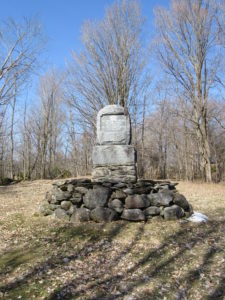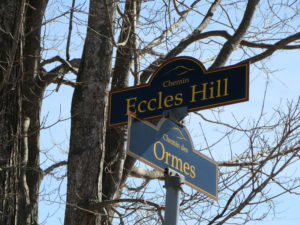(GPS 45° 1’10.00″N 72°54’16.80″W)

Eccles Hill, Quebec Fenian Battle Site, 1873
Various battles and raids occurred along the Canadian border throughout the 19th century. Of obvious historical importance, The War of 1812 brought American aggression across the border at such places as Fort York, Chippewa Falls and Lyons Creek. These forays onto Canadian soil were repeated by the Fenian Brotherhood starting in 1844 most notably at Ridgeway (1866) in the Niagara region and at other smaller venues from New Brunswick to Manitoba such as Eccles Hill, Quebec (May 25, 1870) and ended in 1871.
The Fenians had a grand strategy. Here is a key excerpt from their manifesto:
“With the reduction of Montreal, a demand will be made upon the United States for a formal recognition of Canada, whose name will be changed at once to New Ireland.”
–The Fenian Manifesto (Darch 2014)
As background, the Fenians were Irish immigrants who had served in various American militias and had become battle-hardened during the U.S. civil war. Surviving these battles, the Irish fighters turned their aggression northwards and fought for an independent Ireland by attempting to hold Canada hostage. Except at Ridgeway, all Fenian raids were thwarted by Canadian militia and British troops (Canadian War Museum, The Fenian Raids n.d.).

At the corner of Eccles Hill and Ormes, Frelighsburg, Quebec
“You can’t get there from here” euphemistically describes navigating the roadways to Eccles Hill. It is difficult to find even with a map and a GPS locator. Down unpaved country roads pockmarked with ruts and potholes, adventurers will be surprised to find Eccles Hill overlooking the Canada/ U.S. border by what golfers would gauge as a three wood’s distance away. If you look really closely, video cameras are mounted on some nearby tree trunks.
Deep in the farthest reaches of Quebec’s Eastern Townships close to Frelighsburg, Eccles Hill boasts a surprisingly large concrete block monument situated in a cow pasture behind a nondescript steel gated fence. Below the national historic site’s monument just inside the gate, is a plaque recounting the disastrous Fenian raid that took place here.
Why was the Battle of Eccles Hill designated a National Historic site in 1923? First, the British Army placed the nearest town, Frelighsburg, under military rule when they heard a Fenain raid was imminent. This is the only time in our history a Canadian town was under military rule.
Second, immediately after the six-hundred-strong Fenian Army, commanded by Samuel Spears, crossed the Canadian border, the British army easily defeated them taking five lives, wounding 18 and capturing a their only cannon. The British force of 680 men suffered no injuries or casualties (Battle of Eccles Hill, Wikipedia n.d.) largely the result of information supplied by Thomas Billis Beach, a double agent, prior to the battle.
Eccles Hill typifies Canada’s Irish legacy – a virtually forgotten national historic site hidden in the woods, commemorating a battle left out of our children’s history textbooks.
